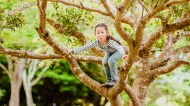As a Pediatric Physical Therapist, one of the most common requests I receive from families is how to encourage walking for those 12 months and up! Once that year birthday mark passes it seems our “new parent” anxiety reaches its peak, questions from family and friends, “So is he walking yet?” My son Abe turned one year old just last week and he is one of the most energetic, inquisitive, active babies I have ever met! But to answer your question, no he is not walking yet. He cruises like a champion, stands independently, can perform squat to stand transitions with perfect form, but he is not an independent walker…yet!
One of the first reassurances I can give families is that motor milestones exist on a continuum. Each child achieves these skills at their own time, in their own way. There are differences in physicality and personality to account for, as well as differences in motivation. Some children are always seeking, searching for new sensory experiences, investigating each new noise, new scent, new image. Other children are happy to be more sedentary, allowing the objects and people in their life to come to them, engage with them on their level. Sometimes we, as parents and caregivers, need to encourage a bit more exploration to facilitate not only motor development, but language acquisition as well.
Tip#1: Encourage barefoot exploration as much as possible. Allowing the child to experience different tactile surfaces with their feet allows for recruitment of the muscles that comprise eventual development of arch support. Barefoot standing and navigation also promotes more natural weight shifting and weight bearing which helps child build both static and dynamic balance necessary for independent walking. So take off your shoes and socks and join in the barefoot walking on grass, sand, padded mats, solid floors…the possibilities are endless!
Tip #2: Move everything from the floor to different surfaces around the play space. Choose different heights, different placements throughout the day, determine the objects that are the most motivating for your child and make those objects the more challenging to reach for. As child squats down low for some objects, reaches up on tiptoes to reach others, not only are we challenging the child’s strength, but also their dynamic balance.
Tip#3: Encourage reaching overhead and down below for objects, bubbles, balloons, putting ball in hoop. This will promote less reliance on upper body external support as the child reaches away from base of support, activating balance reactions, trunk strength and weight bearing through stable lower extremities.
Tip#4: Encourage bi-manual work, activities which engage both hands. Again we are taking the focus away from that external support your child has been relying on. Offer an object that requires both hands to hold and manipulate. Promoting standing and walking while child is engaged bi-manually, will discourage reaching for support and encourage more activation of trunk and lower extremity muscles. A large ball, two musical toys (one for each hand!), a large stuffed animal, anything motivating that requires both hands to be engaged and active so that the child’s trunk and lower body are called upon to maintain balance and stable support.
Tip#5: Encourage transitions! Many of our little ones are pulling to stand using upper body more than lower body to attain this position. We can encourage other means to rise to standing, for instance:
-Sit to stand transitions from low bench or chair promoting knees over toes pushing up into standing (vs using upper body to pull up to stand).
-Floor to stand transitions rising from sitting to tall kneel to half kneel to stand (promoting development of trunk and lower extremity musculature).
Tip#6: Introduce idea of “dynamic support”. Pushing weighted shopping cart, toy car, swing in park, large therapy ball all help to encourage weight bearing and moving through space with “dynamic support”. Promoting weight bearing through legs, weight shifting, and less reliance on stable support as the child has to begin to anticipate the movement and adjust their body accordingly.
Tip #7: Encourage climbing ramps, stairs, and playground slide to promote trunk and lower body dissociation and strengthening.
Tip #8: Change up environment. Bring child to different settings: outdoor playground, indoor gym, friends and families homes. Different settings bring different experiences, new challenges and new incentives to interact physically with surroundings! This is a great way to generalize skills and prevent any degree of complacency.
Tip#9: Enjoy every moment. Despite being sleep deprived, hungry, and stressed….try to enjoy these moments with your little one. Each skill acquired no matter how big or small is a great accomplishment that should be relished and applauded for you and your child!
Tip #10: Ask for help. If all else fails, ask for help. As Pediatric PTs we are able to offer other suggestions, activity ideas, and help to assess any underlying reasons for the developmental concerns you may have. No judgments, just helpful suggestions await if you reach out to the right professional!











